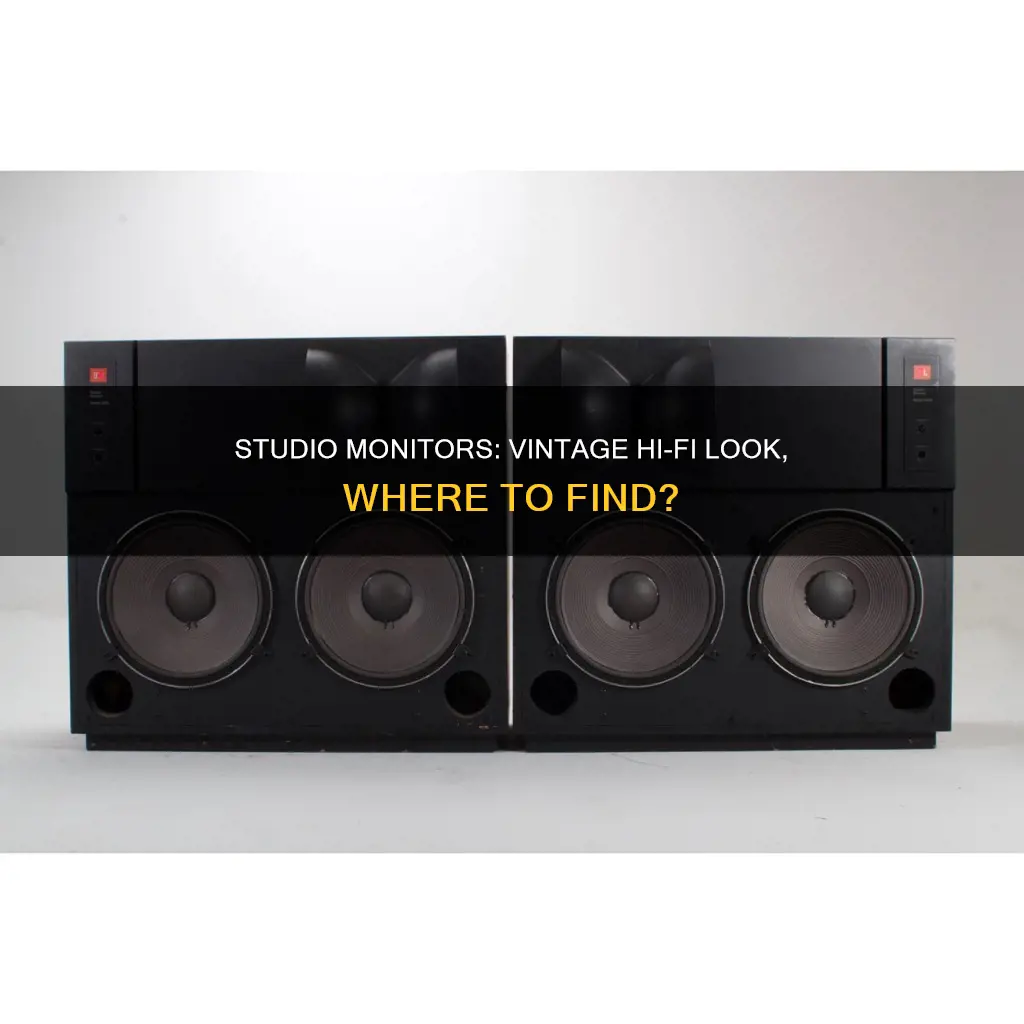
Studio monitors are designed to be ultra-flat so that defects in music can be heard clearly. They are also designed to work best when running at 85dB, which is not very loud. On the other hand, hi-fi speakers tend to be longer-throw so that the full frequency can be heard from a long distance. They are also designed to be cranked up to create a rumble effect.
While there are some high-end models that are intended for both the studio monitor and hi-fi markets, there are some vintage studio monitors with a retro or vintage look. These include the Tannoy SRM12B, or ‘Little Red Monitor” speakers, and the Yamaha NS10M.
What You'll Learn

The Yamaha NS10M Studio Monitor
The NS10M has a distinctive white-coloured mid-bass drive unit, with a black finish cabinet. The revised "Studio" version, introduced in 1987, improved upon the original design with a new tweeter and crossover to address treble problems, sturdier cabinets, and better connection terminals. This version is designed for horizontal orientation, with the logo and connection panel turned 90 degrees.
The Yamaha NS10M has polarised opinions, with some engineers swearing by it and others refusing to use it. Despite this, it has become an industry standard, with over 200,000 pairs of the "Studio" version sold worldwide. The speaker's unique sonic characteristics allow producers to assume that if a recording sounds good on these monitors, it will sound good on most playback systems.
The NS10M has been used to monitor a large number of successful recordings, leading to its recognition as a valuable tool in the music industry. Its use was popularised by legendary engineer Bob Clearmountain, who began using it in the 1980s. The NS10M's longevity and influence were recognised with a Technical Grammy Award for Yamaha in 2007.
Best Places to Buy Studio Monitors in Singapore
You may want to see also

JBL's 4311B and 4312 models
The JBL 4311 and 4312 models are vintage studio monitors with a distinctive look. The 4311 model, specifically the 4311B, is a vintage studio monitor with a dedicated following. While some audiophiles may point out its flaws, such as mediocre upper treble and directivity issues, others admire its unique sound signature and simplicity. The 4311B features a paper-cone tweeter, a 12" woofer, and a rising response LE5-10 midrange driver. Its crossover frequencies are set at 1.5kHz and 6kHz, which may contribute to its distinctive sound.
The JBL 4312 model is another vintage studio monitor with a similar design to the 4311. The 4312 has been described as having a slightly "dry" sound in the bass frequencies when compared to other speakers in the same series. It features a 3-way, 3-driver loudspeaker system with a frequency response ranging from 45Hz to 20kHz. The power handling is 100W, and it is recommended to use an amplifier between 10 and 300W. The bass driver is a 300mm aquaplas cone, the midrange is a 130mm felted paper cone, and the tweeter is a 25mm pure titanium dome.
Both the 4311 and 4312 models have a bass reflex enclosure and dimensions of 597 x 362 x 298mm. The 4312 model has a black fabric grille and a finish of either oiled walnut or studio black. The 4311B model is often housed in a wooden case.
These vintage studio monitors have a unique sound and are sought after by audiophiles and collectors alike. While they may have some limitations when compared to modern studio monitors, they are still highly regarded for their accuracy and sonic neutrality.
Finding Your Monitor's Refresh Rate: A Quick Guide
You may want to see also

KEF speakers
KEF is a British brand that has been making speakers for almost 60 years. The company was founded by Raymond Cooke, a BBC-trained engineer, in 1961. KEF is an acronym for Kent Engineering and Foundry, and the company has been based in Tovil, Maidstone since its inception.
The first KEF speaker was the K1 monitor, a three-way speaker that stood at just over a metre tall. The bass driver used a flat rectangular diaphragm made of aluminium-skinned polystyrene, while the elliptical midrange used the same material. The tweeter, meanwhile, had a Melinex dome, a polyester film known for its high tensile strength and chemical stability. The K1 was available in both ready-built and kit form, with a third, Slimline model featuring the same drivers but in a shallower cabinet.
Since then, KEF has continued to innovate and diversify, expanding its range to include stereo speakers, custom installation solutions, headphones, wireless speakers, and all-in-one streaming systems. The company's trademark technology is its Uni-Q driver array, which disperses sound evenly and aids integration. The first KEF speaker to use this technology was the C35 standmounter, released in 1988.
Over the years, KEF has released several notable speakers, including:
- The Coda 3, which offered excellent stereo imagery and clean, controlled, and well-extended bass.
- The 105/3, which combined KEF's Uni-Q driver with coupled-cavity bass loading tech to lower distortion, improve power handling, and deliver more bass from a small cabinet.
- The Coda 7, which produced an outstanding sound despite a relatively simple design.
- The Q35, a small and compact floorstander that delivered a realistic sonic experience.
- The Reference Model 203, a four-way baby tower with a time-aligned tweeter and Uni-Q driver that offered a dynamic and exciting performance.
- The LS50, a standmounter released in 2013 to mark KEF's 50th anniversary, featuring striking looks and unusually flexible bass reflex ports.
- The Reference 1, a high-end bookshelf speaker that offers brilliant all-around performance.
- The R3, which delivers a level of insight and detail resolution beyond most rivals.
- The LS50 Wireless II, an all-in-one streaming speaker system that addresses the minor imperfections of its predecessor and introduces Metamaterial Absorption Technology for purer treble and cleaner mids.
In addition to these models, KEF has also released vintage speakers that are still sought-after and in use today, such as the KEF Corelli and the KEF Chorale III.
IAQ Monitors: Breathe Easy with Smart Home Solutions
You may want to see also

Tannoy DC200
The Tannoy DC200 is a dual-concentric loudspeaker system, meaning that all the sound comes from the same place: a point source. This is achieved by locating the tweeter in the centre of the bass driver, which also shares the same magnetic assembly. The drive units are 'time aligned' to prevent phase problems around the crossover point. This point-source aspect is important in home studios as the operator usually sits close to the monitors to exclude reflected room sound.
The DC200 is a 2-way, 2-driver loudspeaker system with a frequency response of 45Hz to 20kHz and a power handling of 150W. The recommended amplifier power is between 10 and 120W, and the crossover frequency is 1800Hz. The enclosure is 33 litres and bass reflex, with a grille covered in acoustic cloth and a finish of walnut vinyl veneer. The dimensions of the speaker are 560 x 330 x 265mm.
The DC200 offers tremendous clarity and detail, with great midrange, bass, and treble response. It also has exceptional timing and classic looks. However, the cabinet has been noted as a potential drawback, with some suggesting that additional damping inside may be beneficial.
The DC200s have been praised for their precise imaging, which is advantageous for monitoring. They provide a smooth high-frequency response and a "soft-centred" sound characteristic of Tannoy speakers. While the bass response is modest, this can be advantageous in untreated rooms, as it prevents the excitation of troublesome resonances. The DC200s offer an improvement in transparency when the grilles are removed.
Overall, the Tannoy DC200 is a versatile speaker that can serve as both a home stereo and a recording monitor. While they may not provide the same punch as larger speakers, they offer excellent value and are well-suited for small studios or home use.
Blind Spot Monitor: Is It Available on the Toyota Venza?
You may want to see also

Vintage Yamaha Speakers NS-344
The Yamaha NS-344 speakers are a pair of vintage hi-fi studio reference monitors with a bookshelf speaker design. They were manufactured sometime in the late 1970s or early 1980s and feature a wood grain finish, giving them a classic, vintage look. These speakers were designed to be used in a professional studio environment and offer clear, high-fidelity sound.
The Yamaha NS-344 speakers are a 3-way speaker system, with a 9-inch woofer, a 4-inch mid-range driver, and a 1-inch tweeter. They have a power rating of 35 Watts RMS and can handle up to 70 Watts at peak power. The speakers also feature attenuator controls, allowing for adjustments to the high and mid-level frequencies. The front cover is removable, providing easy access to these controls and the drivers.
These vintage Yamaha NS-344 speakers are a rare find and are known for their excellent sound quality and durability. While they may show some signs of cosmetic wear, they remain fully operational and function as intended. The grills and drivers are typically in very good condition, and the cabinets usually have minimal marks or scratches.
The Yamaha NS-344 speakers have a dedicated following among audio enthusiasts and collectors. They are often sought after for their unique sound signature and retro aesthetic. These speakers are a "big brother" upgrade to the classic Yamaha NS-10, offering enhanced performance and a more powerful listening experience.
If you're looking for a pair of vintage studio monitors that combine style and functionality, the Yamaha NS-344 speakers are an excellent choice. They deliver high-quality audio reproduction and a stylish retro design, making them a standout addition to any home studio or audio setup.
Please note that these speakers may not be readily available in your area, and you may need to source them from online marketplaces or specialist audio retailers.
Differentiating TVs and Monitors: What You Need to Know
You may want to see also
Frequently asked questions
Yes, there are studio monitors with a vintage look that can also be used for hi-fi listening. Some examples include the JBL 4311B, the Yamaha NS-10M, and the Tannoy DC200.
Vintage hi-fi speakers can offer excellent sound quality and clarity, sometimes even outperforming budget "pro" monitors. They may also be more affordable than purchasing new speakers.
One potential issue is the term "vintage" itself, as loudspeakers are electro-mechanical devices that can wear out over time. Suspensions can degrade, sealing gaskets may harden, and electrical components can change value, leading to distortion. Additionally, hi-fi speakers may not be designed to handle the same volume levels as professional studio monitors, especially for extended periods.







